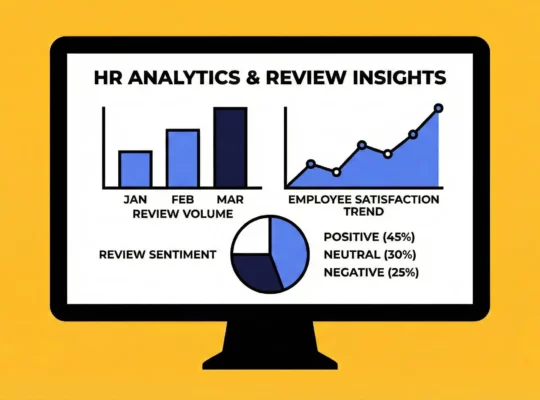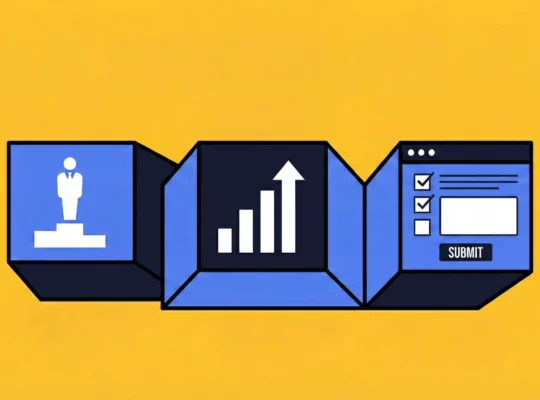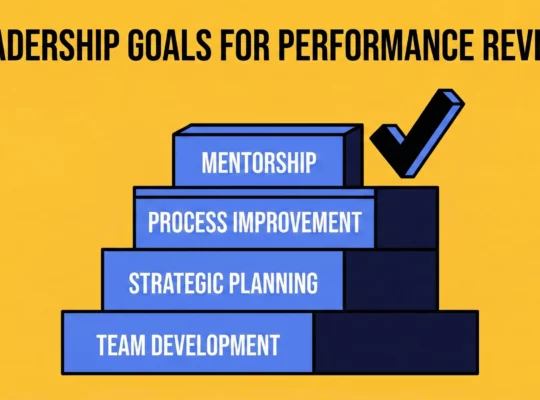Traditional performance management systems, characterized by annual reviews and sporadic feedback, often fall short in addressing the dynamic needs of modern workplaces. Enter continuous feedback performance management, an innovative approach that emphasizes regular, constructive feedback to enhance employee engagement and performance. At Review.jobs, we understand the importance of adapting to these modern feedback systems to drive organizational success.
- What is Continuous Feedback Performance Management?
- How it Differs from Traditional Annual Performance Reviews
- 3-Step Guide to Continuous Feedback Performance Management
- Benefits of Continuous Feedback Performance Management
- Implementing Continuous Feedback in Your Organization
- Challenges and Solutions in Continuous Feedback Performance Management
I. What is Continuous Feedback Performance Management?
Continuous feedback performance management is a system where feedback is given regularly rather than waiting for an annual review. This approach focuses on real-time feedback, frequent check-ins, and ongoing dialogue between managers and employees. Unlike traditional performance reviews, which often leave employees feeling anxious and undervalued, continuous feedback promotes a culture of transparency and growth. That is why it is crucial to prepare a list of insightful performance review questions for optimal results.
II. How it Differs from Traditional Annual Performance Reviews
Traditional annual performance reviews tend to be retrospective, evaluating an entire year’s worth of work in a single meeting. This method can be stressful for employees and managers alike, often leading to a lack of actionable insights and delayed improvements. Continuous feedback, on the other hand, involves regular interactions that provide timely, specific feedback, helping employees make adjustments and improvements in real-time.
III. 3-Step Guide to Continuous Feedback Performance Management
1. Leverage Employee Reviews with Review.jobs
Regular, constructive feedback is vital for employee growth and organizational success. However, creating a streamlined and effective feedback loop can be challenging. This is where Review.jobs steps in!
We offer a suite of tools designed to simplify and enhance the continuous feedback process, fostering a culture of learning and development within your organization.
Key Features of Review.jobs for Enhanced Feedback
- Anonymous Review Collection: Empower employees to provide honest and open feedback without fear of retribution, leading to more valuable insights.
- Customizable Response Templates: Structure constructive feedback by providing managers with pre-defined templates focused on specific skills or areas of development. This ensures targeted and relevant feedback for employees.
- In-Depth Review Analysis: Gain actionable insights from collected feedback through powerful analysis tools. Uncover trends, identify areas for improvement, and measure the impact of your feedback initiatives.
- Seamless Website Integration: Effortlessly integrate Review.jobs with your existing HR or performance management systems. This streamlines data collection and analysis, saving time and resources.
2. Conduct Regular Check-ins
Frequent manager-employee interactions are the cornerstone of continuous feedback and performance management. Conducting check-ins fosters open communication, builds trust, and ensures employees feel supported.
Types of Check-ins
- Daily Check-ins: Brief, informal touchpoints to address immediate concerns, share updates, and maintain alignment.
- Weekly Check-ins: More structured discussions focusing on progress, challenges, and goal attainment.
- Bi-weekly Check-ins: In-depth conversations for performance reviews, career development, and feedback exchange.
Benefits of Regular Check-ins
- Improved Communication: Frequent interactions enhance understanding and prevent misunderstandings.
- Enhanced Employee Engagement: Regular check-ins demonstrate that employees are valued and heard.
- Early Issue Detection: Identifying potential problems early allows for timely interventions.
- Performance Improvement: Regular feedback helps employees stay on track and achieve goals.
- Stronger Relationships: Consistent check-ins build trust and rapport between managers and employees.
3. Set Goals and Track Progress
Clear and measurable goals are essential for effective performance management and employee development. By establishing specific objectives and tracking progress, organizations can ensure that employees are aligned with organizational goals and making steady progress toward their career aspirations.
Setting SMART Goals
To maximize the impact of goal setting, it’s crucial to establish goals that are:
- Specific: Clearly defined and focused on a particular outcome.
- Measurable: Quantifiable with clear metrics to track progress.
- Achievable: Realistic and attainable within a given timeframe.
- Relevant: Aligned with the employee’s role and the organization’s objectives.
- Time-bound: With specific deadlines to create a sense of urgency.
Continuous Tracking and Feedback
Regularly monitoring progress toward goals is essential for providing timely feedback and making necessary adjustments.
- Performance Metrics: Establish key performance indicators (KPIs) to measure progress towards goals.
- Check-ins: Conduct regular check-ins to discuss goal progress and provide feedback.
- Adjustments: Be prepared to modify goals as needed based on changing circumstances or priorities.
IV. Benefits of Continuous Feedback Performance Management
Continuous feedback is a cornerstone of modern performance management, offering numerous advantages for both employees and organizations. By shifting from traditional, annual performance reviews to ongoing feedback, organizations can foster a culture of growth, development, and high performance.
Enhanced Employee Engagement
- Increased Motivation: Regular feedback validates employees’ contributions, boosting morale and motivation. When employees receive consistent and constructive feedback, they understand that their efforts are recognized and valued. This acknowledgment serves as a powerful motivator, encouraging them to maintain high performance and strive for excellence.
- Stronger Relationships: Open communication fostered by continuous feedback strengthens bonds between employees and managers. Regular interactions create opportunities for meaningful dialogue, allowing managers to understand their team members’ strengths, challenges, and career aspirations better.
- Sense of Belonging: Feeling heard and valued through frequent feedback contributes to a stronger sense of belonging. Employees who receive regular feedback are more likely to feel that they are an integral part of the organization. This sense of inclusion can enhance their commitment and loyalty to the company.
Improved Productivity
- Faster Problem Resolution: Early identification and addressing of issues prevent productivity bottlenecks. Continuous feedback allows managers and employees to promptly spot and resolve problems before they escalate. This proactive approach minimizes disruptions and keeps projects on track.
- Goal Alignment: Regular check-ins ensure employees are aligned with organizational objectives. Through frequent discussions, managers can clarify expectations and provide guidance to keep employees focused on the company’s goals. This alignment helps ensure that individual efforts contribute meaningfully to the broader organizational mission.
- Skill Development: Timely feedback accelerates skill acquisition and performance improvement. When employees receive immediate and specific feedback, they can quickly identify areas for improvement and take corrective action. This rapid learning cycle enhances their skills and capabilities, enabling them to perform better in their roles.
Reduced Turnover Rates
- Increased Job Satisfaction: According to Harvard Business Review, regular feedback goes hand in hand with increased job satisfaction levels. Employees who receive regular, constructive feedback feel more valued and supported in their roles. This continuous interaction helps them understand their contributions and areas for improvement, leading to a sense of achievement and fulfillment.
- Improved Retention: Engaged and satisfied employees are less likely to seek employment elsewhere. In fact, feedback can reduce turnover rates by 14.9% and promote employee loyalty! This translates to higher retention rates as employees who feel valued and see opportunities for growth within the company are less inclined to look for new job opportunities.
- Stronger Employer Brand: A culture of continuous feedback enhances the company’s reputation as an employer of choice. Organizations that prioritize regular feedback and open communication are often seen as more attractive places to work. Prospective employees are drawn to companies where they know their contributions will be recognized, and their development will be supported.
Data-Driven Decision Making
- Performance Insights: Continuous feedback provides valuable data for performance analysis and talent management. By consistently collecting and reviewing feedback, organizations can identify trends and patterns in employee performance.
- Strategic Planning: Insights from feedback can inform workforce planning and development initiatives. Continuous feedback generates a wealth of data that can be used to identify skill gaps, predict future training needs, and plan for succession.
- Measurable Impact: Tracking the effectiveness of feedback programs helps demonstrate ROI. Continuous feedback systems allow organizations to measure the impact of their feedback initiatives by tracking key performance indicators (KPIs) such as employee engagement, productivity, and turnover rates.
V. Implementing Continuous Feedback in Your Organization
Creating a Feedback Culture
Fostering a culture of open communication and feedback requires a deliberate effort. Steps to create such a culture include:
- Encouraging open dialogue and transparency.
- Recognizing and celebrating achievements.
- Providing training on giving and receiving feedback.
70% of employees testify that feedback improves workplace culture. Leaders play a crucial role in promoting continuous feedback by modeling behavior and setting expectations.
Training Managers as Coaches
For continuous feedback to be effective, managers need to adopt a coaching mindset. Training programs and resources can help managers develop the skills needed to provide constructive feedback and support employee development.
Using Technology for Continuous Feedback
Various tools and software can facilitate continuous feedback. These technologies streamline the feedback process, making it easier to collect, analyze, and act on feedback. Some benefits include:
- Real-time feedback: Immediate and actionable insights.
- Performance tracking: Monitoring progress towards goals.
- Engagement analytics: Understanding employee sentiment and engagement levels.
VI. Challenges and Solutions in Continuous Feedback Performance Management
Implementing a successful continuous feedback system requires careful planning and execution. Here are some common challenges and potential solutions:
Time Management
- Challenge: Balancing the demands of daily work with the need for regular feedback.
- Solutions:
- Time Blocking: Dedicate specific time slots for feedback discussions.
- Leverage Technology: Use tools to automate routine feedback tasks.
- Prioritize Feedback: Focus on high-impact feedback areas.
Providing Constructive Feedback
- Challenge: Delivering feedback effectively without causing defensiveness or demotivation.
- Solutions:
- Focus on Behavior: Describe specific behaviors rather than making personal judgments.
- Use “I” Statements: Express feedback from a personal perspective to avoid sounding accusatory.
- Offer Solutions: Provide suggestions for improvement along with constructive criticism.
Maintaining Accountability
- Challenge: Ensuring that feedback is acted upon and leads to measurable improvements.
- Solutions:
- Clear Expectations: Set clear expectations for feedback follow-up and action plans.
- Regular Check-ins: Monitor progress and provide support to employees.
- Link Feedback to Performance Goals: Connect feedback to overall performance objectives.
Continuous feedback performance management is revolutionizing the way organizations approach employee growth and engagement. By adopting continuous feedback practices, companies can foster a more engaged, productive, and satisfied workforce. At Review.jobs, we are committed to helping organizations implement effective feedback systems that drive success. Start your journey towards a more engaged and productive workforce with continuous feedback performance management today.
FAQs
What is continuous feedback performance management?
Continuous feedback performance management is a system where feedback is given regularly, rather than waiting for an annual review. It involves real-time feedback, frequent check-ins, and ongoing dialogue between managers and employees to promote continuous improvement and engagement.
How does continuous feedback differ from traditional annual performance reviews?
Unlike traditional annual performance reviews, which are retrospective and infrequent, continuous feedback is regular and ongoing. It provides timely, specific feedback, helping employees make real-time adjustments and improvements.
What are the benefits of continuous feedback performance management?
Benefits include enhanced employee engagement, improved productivity, and reduced turnover rates. Regular feedback fosters a culture of engagement, helps address issues promptly, and leads to higher employee satisfaction and retention.
How can my organization implement continuous feedback?
Implementing continuous feedback involves fostering a culture of open communication, training managers as coaches, and using technology to facilitate feedback. Regular check-ins, goal setting, and tracking progress are also essential components.
What tools can help with continuous feedback performance management?
Various tools and software are available to streamline the feedback process, such as real-time feedback systems, performance tracking tools, and engagement analytics platforms. These technologies make it easier to collect, analyze, and act on feedback.
How can managers provide constructive feedback effectively?
Managers can provide constructive feedback by being specific, timely, and balanced. Focusing on specific behaviors and outcomes, providing feedback as soon as possible, and including positive comments alongside areas for improvement are key techniques.
What role does Review.jobs play in continuous feedback performance management?
Review.jobs offers tools to streamline the continuous feedback process, including anonymous review collection, customizable response templates, in-depth review analysis, and seamless website integration, helping organizations implement effective feedback systems.





